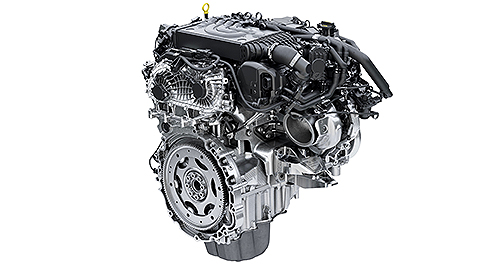News - JaguarJLR confirms thrifty inline sixLeaner: An electric supercharger that can spool up instantaneously will eliminate lag in JLR’s new 3.0-litre inline six-cylinder petrol engine that also will benefit from mild hybrid assistance. Up to 20 per cent fuel saving coming to six-cylinder Jaguars, Land Rovers in 202013 Feb 2019 JAGUAR Land Rover is promising fuel savings of up to 20 per cent, fewer tailpipe pollutants and greater responsiveness from a new 3.0-litre straight-six petrol engine that will join its Ingenium powerplant family in 2020 when it will wend its way to Australia in a yet-to-be-announced model.
Armed with a fast-spooling electric supercharger in tandem with a twin-scroll turbocharger, the engine is said to be more responsive from idle than the current Ford-sourced 3.0-litre V6 that graces a wide selection of JLR models, from the Jaguar XE, F-Type, F-Pace, XF and XJ to the Range Rover Velar and Vogue.
In a way, the new engine takes JLR back to its roots at Jaguar which has a rich history of inline sixes, including the famous XK6 that did duty from 1949 to 1992 in a variety of sizes, most notably 3.8 and 4.2 litres.
Because inline sixes are inherently better balanced than a bent six, the new engine is said to be smoother for silkier acceleration.
Part of the fuel savings come from a 48-volt mild hybrid system that kicks in under acceleration, not only cutting fuel consumption but also boosting performance. Like similar systems from other manufacturers, including Mercedes-Benz, the motor also acts as a generator, recouping energy under deceleration to charge a small battery with electricity for later use.
Theoretically, a 20 per cent fuel saving would cut the consumption of a Jaguar XE in its 3.0 S supercharged form from 8.1 litres per 100km on the combined fuel test cycle in Australia to about 6.5L/100km.
A particulate filter will cut sooty emissions by 75 per cent, helping the engine meet the latest emissions tests in Europe.
Designed in-house, the engine will be produced in 265kW/495Nm and 294kW/550Nm states of tune, which makes it no more powerful than the current V6 which comes in 250, 280 and 294kW variants. The latter is fitted to the Jaguar F-Type 400 Sport.
However, the focus is on delivering a cleaner and more efficient engine to meet stricter global regulations while also improving responsiveness and smoothness.
JLR executive director of product engineering Nick Rogers said Ingenium was always intended to be a full family.
“That is why we chose to engineer our own flexible engine architecture to meet our bespoke needs, allowing Jaguar Land Rover to adapt and stay ahead of changes in regulation and technology,” he said.
“This second wave of engines, with a mild hybrid 48-volt system and performance-boosting technologies, is engineered to be cleaner and more efficient than ever before.”
The new engine will go global in 2020, but the United Kingdom is set to get it early in a limited-edition Range Rover Sport HST. That vehicle is not destined for Australia.
JLR Australia public relations manager James Scrimshaw confirmed the new powerplant for Australia from 2020 but said he could not yet say which model would have the honour of making its debut.
The new engine will be built alongside Ingenium four-cylinder petrol and diesel powerplants at JLR’s Wolverhampton factory. From 2020, electric drive units will also be turned out from that plant.  Read more |
Click to shareJaguar articlesResearch Jaguar Motor industry news |

















Facebook Twitter Instagram